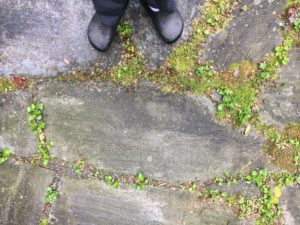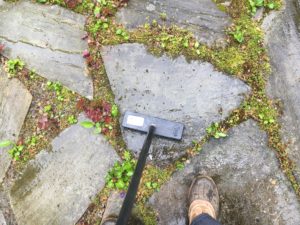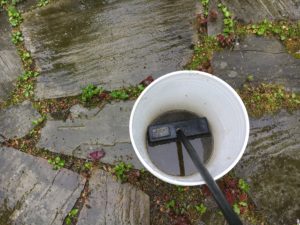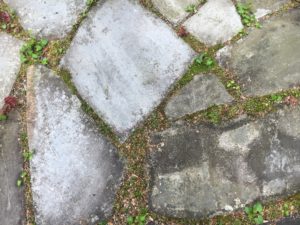Hello, Fellow Lovers of All Things Green, The recent rains turned the stone patio into an ice-skating rink. I adore the moss between the joints, but the presence of moss often goes hand in hand with mildew, which is slippery when wet. Indeed, it’s time to clean the stones. But how best to clean patios and walks without damaging the stone or plants— one of my nagging dilemmas.
Mildew is a fungus that typically grows flat on surfaces and is often inconspicuous in gray, brown, or black tones, though sometimes green, yellow, or white. Conversely, moss is a simple, non-vascular, and rootless plant that grows in charming fuzzy mats or clumps that absorb nutrients and water and reproduce with spores.

Before the Baking Soda Technique
Power Washing Natural Stone is Risky
I once used a power washer, which is risky for damaging the stone. Then there’s the ick factor of scum kicking back at you. More than that, there’s the likelihood of kicking out the sand and green goodies in the nooks and crannies. The power washing outcome was clean centers of each stone, while the areas near the joints remained green. Not so pretty. So, I sought other remedies – all are best to do on cloudy days so the cleaning solutions won’t dry on the surface. Perhaps it is obvious to blow off the surface dirt before you clean the stones.
Safe Ways to Clean Stone Patios
Folks swear by a product called Wet and Forget. As the name touts, all you do is spray it. The ingredients are water, benzyl ammonium chloride, and ethanol, which are safe for plants. I hate to break the news, but you need to scrub the patio for it to be effective. Here are other remedies to try.
A good old soapy water mix made from three tablespoons of biodegradable dish soap (free of harmful bleach or fragrance) to one gallon of warm water, can do the trick. Be sure to use a plastic or natural-bristle deck brush; never a metal brush, as it will scratch. Keep in mind that plants have a wax covering that is affected by soap, so stay clear of the crannies. After scrubbing, dilute the soapy water with the garden hose to keep your plants happy.

Trying the Baking Soda Technique

Oh, the Dirty Water!
They say you can use two cups of oxygenated bleach to a gallon of warm water. Unlike chlorine bleach, oxygenated bleach doesn’t have a toxic smell and is safe around pets. Oxygenated bleach is made of sodium carbonate (soda ash) and a dry form of hydrogen peroxide. The challenge is finding one without harmful additives.
You can also use the oxygenated bleach and water combo to clean wood, composite decks, and indoor tile grout. Some reviewers said it might hurt moss, so do your best to avoid the fuzz. There’s a product called Stain Solver with no added fillers or fragrances made of pure sodium percarbonate, a form of oxygenated bleach, and natural soda ash. Spray the mix with a garden hand pump sprayer and allow it to soak for ten minutes before scrubbing. Then rinse with water.
Outcomes of the Baking Soda Technique is Promising
Four tablespoons of baking soda (sodium bicarbonate) dissolved in a quart of warm water are safe on wood, concrete, and natural stone and won’t harm plants. They say baking soda helps lessen the impact of powdery mildew and several other fungal diseases. Sounds promising! After you scrub, you’ll need to rinse thoroughly so no white residue is left behind.
I tried the baking soda technique. While the half-hour test run proved encouraging in terms of outcome, multiplied by the square footage, I figure the total task will take about six to eight hours. Oh my!
Like getting rid of undesirable things in the garden of life, I suppose there’s no effortless way of cleaning your dirty dilemmas. But how gratifying when you can walk with sure-footedness amongst fabulous moss, sedums, and other nook and cranny plants. Garden Dilemmas? AskMaryStone@gmail.com and your favorite Podcast App.
Links to Related Posts and Podcasts You’ll Enjoy:



